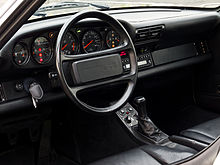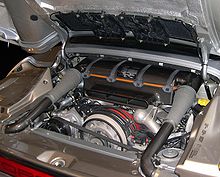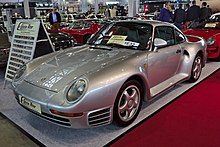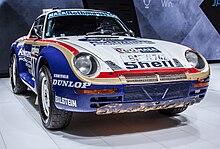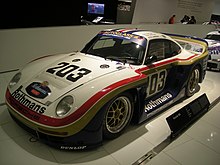Porsche 959
Combining race-car performance with luxury-sedan comfort and everyday drivability in dry, wet and snowy conditions, it was considered the most technologically advanced road car of its time.
Development of the 959 (originally called the Gruppe B) started in 1981, shortly after the company's then-new Managing Director, Peter Schutz, took his office.
Bott knew that the company needed a sports car that they could continue to rely on for years to come and that could be developed as time went on.
Curious as to how much they could do with the rear-engined 911, Bott convinced Schutz that development tests should take place, and even proposed researching a new all wheel drive system.
The powerplant is a sequential twin-turbocharged DOHC flat-six engine equipped with 4 valves per cylinder, fuel fed by Bosch Motronic 2.1 fuel injection with air-cooled cylinders and water-cooled heads, with a bore x stroke of 95 mm × 67 mm (3.74 in × 2.64 in) for a total displacement of 2,849 cc (173.9 cu in).
It was coupled to a unique manual transmission offering six forward speeds with the first gear labelled "gelände" (terrain), allowing the car to pass noise regulations, as well as reverse.
Under hard acceleration, PSK could send as much as 80% of the available power to the rear wheels, helping make the most of the rear-traction bias that occurs at such times.
[16] It could also vary the power bias depending on road surface and grip changes, helping maintain traction at all times.
The dashboard featured gauges displaying the amount of rear differential slip as well as transmitted power to the front axle.
After the first two prototypes, the bodywork was modified to include air vents in the front and rear wheel housings, as well as intake holes behind the doors.
[citation needed] The road version of the 959 debuted at the 1985 Frankfurt Motor Show as a 1986 model, but numerous issues delayed production by more than a year.
The cars were sold to selected collectors after being driven by works personnel for some time[1] and are today by far the most sought-after 959 models.
To save weight, air conditioning, central locking, electric window lift, rear seats and the levelling system for the chassis were omitted.
The first development race cars, essentially modified 911 Carrera models with all-wheel-drive system known internally as the 953, were entered in the 1984 Paris-Dakar Rally, finishing 1st (René Metge), 6th (Jacky Ickx) and 25th.
Unlike the World Rally Championship the Dakar didn't require a minimum number of cars built for homologation.
[34] Owners of the few 959s that entered the country paid storage fees to keep their 959s in so-called Foreign Trade Zones (areas adjacent to US ports where goods are not considered to be in the US for legal purposes) as the cars weren't permitted in the US proper.
[35] On August 13, 1999, the "Show or Display" law came into force, allowing usage of the car limited to 2,500 annual road miles.
[36][37][38] All 959 cars are now over 25 years old, and therefore no longer need to comply with the unique NHTSA and EPA regulations to avoid destruction by U.S. Customs and Border Protection.
